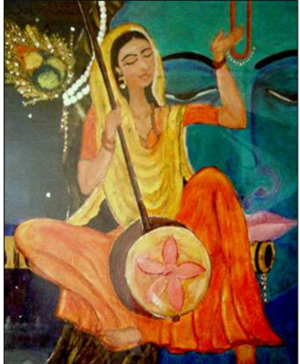Talk:Bhakti and Bhakti-Yog
By Vishal Agarwal
Bhakti means loving devotion and service towards the Lord.[1] In the Ṛgveda and other Veda-s, there are thousands of verses in which ṛṣi-s express their bhakti for various Deva-s like Indra, etc.[2][3][4] The Veda-s also clarify that these different Deva-s derive from a single underlying Supreme Being or are merely different aspects of the same Lord.
The Veda-s contain the spontaneous spiritual inspirations of the great ṛṣi-s, the seers, who had come face to face with the Divine. Therefore, although the Veda-s depict all facets of bhakti, they do not give a systematic and methodical description of bhakti or any other path to mokṣa as an organized spiritual system. The earliest description of bhakti as a systematic discipline to reach the Divine (bhakti-yoga) is taught in the Bhagavad Gītā. The Bhagavad Gītā teaches it as its fourth yoga or spiritual discipline, after jñāna-yoga, karma-yoga, and dhyāna-yoga. Its chapters 9–12 deal exclusively with bhakti and bhakti-yoga, although bhakti-related concepts are touched upon in earlier and later verses. Kṛṣṇa says that bhakti is the crown of one's spiritual journey, although it must be combined with other yoga-s in various degrees depending on one's inherent nature.
The goal of all four yoga-s of the Bhagavad Gītā is to reach the Divine. But most modern Hindus prefer the path of bhakti-yoga, specifically the way of loving devotion towards a saguṇa Brahman. Some Hindus also practice bhakti-yoga with nirguṇa Brahman as the goal. Sikhs focus on bhakti towards nirguṇa Brahman as well. It must be emphasized, however, that there is no sharp and complete distinction between bhakti/bhakti-yoga towards saguṇa and nirguṇa Brahman. The difference is simply one of focus. Sant Sūrdās, for instance, focuses on saguṇa (as Kṛṣṇa) in hundreds of hymns, although a hymn or two of his is in the nirguṇa mode. The Sikh Gurus focus on nirguṇa, but have numerous hymns in which they celebrate the different avatāra-s of Viṣṇu (saguṇa bhakti) and their deeds as narrated in the Bhāgavata Purāṇa.
After the Bhagavad Gītā, the philosophy of bhakti and bhakti-yoga is expounded systematically in great detail in the Bhakti Sūtra-s of Sage Nārada and in the Bhakti Sūtra-s of Sage Śāṇḍilya.[5][6] The practice of bhakti is presented in the Bhāgavata Purāṇa, a widely followed Hindu scripture. The Purāṇa-s and Āgama-s, which teach details about worshipping Devī, Viṣṇu, Śiva, etc., are also vast compendiums of bhakti and bhakti-yoga.
Bhakti-yoga is considered one of the easiest paths to reach the Divine among the four yoga-s, with the fewest prerequisites. It is also the most popular spiritual path that is found in some way or the other in all religions.
References[edit]
- ↑ Miller, Jeanine. Does Bhakti Appear in the Rigveda? Bharatiya Vidya Bhavan, 1996.
- ↑ Miller, Jeanine. Does Bhakti Appear in the Rigveda? Bharatiya Vidya Bhavan, 1996.
- ↑ Sangoram, K. D. Pathway to God in the Vedas. Solapur, Maharashtra: B. R. Kulkarni, 1995.
- ↑ Bose, Abinash Chandra. Hymns from the Vedas. Bombay: Asia Publishing House, 1966.
- ↑ Chinmayananda, Swami. Nārada Bhakti Sūtra. Bombay: Central Chinmaya Mission Trust, 1982.
- ↑ Swami Harshananda. Śāṇḍilya Bhakti Sūtra-s with Svapneśvara Bhāṣya. Bangalore: Ramakrishna Math, 2002.

